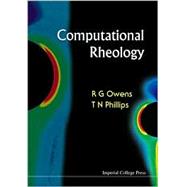Techniques of Computational Rheology traces the development of numerical methods for non-Newtonian flows from the late 1960's to the present day. It begins with broad coverage of non-Newtonian fluids, including their mathematical modelling and analysis, before specific computational techniques are discussed. The application of these techniques to some important rheological flow problems of academic and industrial interest is then treated in a detailed and up-to-date exposition. Finally, the reader is kept abreast of ideas at the cutting









